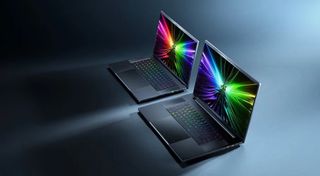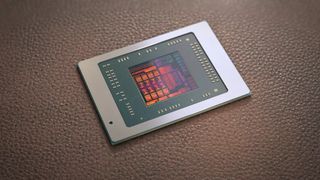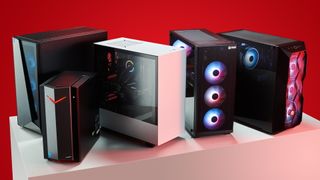The first official AI PCs are just about to land but they're not what you're expecting
What, exactly, is an AI PC?

AI, everywhere, all at once. The AI boom is utterly overwhelming and the PC, inevitably, is not immune. About a month from now, you'll be able to buy a machine that officially qualifies as an "AI" PC, according to no lesser an authority than Microsoft. But you might be surprised what's powering it.
Of course, the very question of what qualifies as "AI" is tricky enough. When do a few clever algorithms and a pattern-spotting routine or two actually become artificial intelligence in a meaningful sense?
Right now, there's actually debate over the possibility that the latest chatbots might be sentient. Personally, I don't think text prediction amounts to actual intelligence, much less sentience. Large language models are meant to do a convincing job of predicting text. And they do just that, which is not a cause to impute mystical higher functionality emerging out of nothing.
That may happen, eventually. In the meantime, we have the term "AI" plastered all over everything. Later this year, that will include the PC. Microsoft is obviously one of the most important players in both AI and PC tech. So however arbitrary it is, what Microsoft decides should make for an AI PC will become something of a de facto standard.
Unsurprisingly, Microsoft has decided that an AI PC needs to be running its Copilot AI assistant. Somewhat fatuously, an AI PC according to Microsoft will also need to have a physical Copilot button on the keyboard. Perhaps a sticker over the right-hand alt key and a quick remap will do for that bit.
Last but far from least, a Microsoft-endorsed AI PC must have an NPU or Neural Processing Unit with at least 45 TOPS of processing power. That's a dedicated unti in the chip just for AI processing. Any additional TOPS generated by CPU or GPU cores don't count. Those 45 TOPS must come from the NPU. So, without getting into the weeds over the various ways TOPS can be measured, the claimed 686 TOPS of an RTX 4090 mobile GPU don't count, nor do the 194 TOPS of an RTX 4050 mobile. Them's the rules, even if it doesn't make any sense.

TOPS, of course, stands for Trillion Operations Per Second. Now it's not clear exactly where that figure of 45 TOPS comes from or why Microsoft chose it. But you can be pretty confident it wasn't arrived at without consultation with the likes of Intel and AMD.
The biggest gaming news, reviews and hardware deals
Keep up to date with the most important stories and the best deals, as picked by the PC Gamer team.
It is therefore precisely no surprise at all that Intel's next-gen mobile CPU, codenamed Lunar Lake and due out by the end of the year, will offer, yup you guessed it, precisely 45 TOPS from its second-gen NPU. Intel's latest Meteor Lake laptop CPUs also have a dedicated NPU for AI processing. But it only offers 11 TOPS of performance.
As for AMD, its Hawk Point APU has a slightly more powerful NPU at 16 TOPS. But that's still well short of what's required to qualify as an AI PC. And wouldn't you know it, AMD says its upcoming Strix Point chip for laptops will have three times the NPU performance of Hawk Point, putting it just over that 45 TOPS target. What a coincidence.
It was actually AMD that was first to market with a PC chip with an NPU. The Phoenix APU as seen in all those handheld gaming machines and lots of laptops had essentially the same NPU as Hawk Point.

Best gaming PC: The top pre-built machines.
Best gaming laptop: Great devices for mobile gaming.
However, what you might be surprised to learn is that there's a good chance that the first PCs to qualify for Microsoft's AI definition might well be powered by a chip from neither Intel nor AMD. In fact, the first AI PCs might not be traditional x86 PCs at all. Instead, they'll be powered by Qualcomm's new Snapdragon X Elite SoC which of course uses the Arm instruction set rather than x86.
Can you guess how many TOPS the NPU in the X Elite cranks out? I bet you can. Once again, it's the magic 45 TOPS figure. The first laptops with the X Elite are due to go on sale in June. That's definitely long before Intel will have any Lunar Lake laptops on the market. Intel says Lunar Lake is a 2024 product, but odds are it'll barely be available by the end of the year.
By my reckoning, those X Elite portables are also likely to beat AMD's next-gen Strix Point APU to market, too. I suspect Microsoft will want to make a big splash with the arrival of those first "AI" laptops, which will make for a nice injection of free PR for Qualcomm. But it'll be odd to see the first big push into AI for the PC in consumer awareness terms come from a non-x86 platform.
Will it be seen in hindsight in the turning point for the PC from x86 to Arm? Possibly. In the meantime, we're left to ponder what all those TOPS will do aside from hide the mess on your bedroom floor in Zoom meetings and generate mildly disturbing cartoon meme images locally as opposed to up in the cloud. But whatever we end up doing with our brave new AI PC overlords, it's remarkable that it will be Arm-powered PCs making the early running in PR terms if nothing else.

Jeremy has been writing about technology and PCs since the 90nm Netburst era (Google it!) and enjoys nothing more than a serious dissertation on the finer points of monitor input lag and overshoot followed by a forensic examination of advanced lithography. Or maybe he just likes machines that go “ping!” He also has a thing for tennis and cars.
Most Popular

